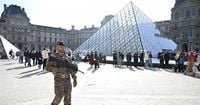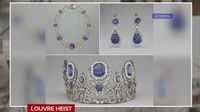Paris is no stranger to drama, but the events of October 19, 2025, have left the city and the world reeling. In the early morning hours, masked thieves disguised as construction workers pulled off one of the most audacious heists in recent memory at the Louvre Museum, making off with more than $100 million worth of historic French jewelry. Despite a flurry of arrests and an ongoing manhunt, the priceless jewels—steeped in Napoleonic history—remain missing, and questions about museum security are swirling like autumn leaves in the Tuileries Garden.
The heist, which unfolded with cinematic precision, saw the robbers use a stolen basket lift to reach the windows of the Apollo Gallery, where some of France’s most prized Napoleonic-era jewels and royal artifacts were displayed. Armed with an angle grinder and disc cutter, the group broke through the glass casings and made their escape on motorcycles—all in a jaw-dropping seven minutes, according to The Associated Press. The thieves targeted nine items, including tiaras, necklaces, earrings, and brooches once belonging to Queen Marie-Amélie, Queen Hortense, Marie-Louise, and Empress Eugénie. The crown of Empress Eugénie was found at the scene, but it was damaged; the rest vanished without a trace.
Paris prosecutor Laure Beccuau provided updates on the investigation in a series of statements to French radio RTL News and at a press conference. According to Beccuau, five more suspects were arrested late on October 29, 2025, in Paris and its surrounding region. These new arrests brought the total number of individuals in custody to seven. Among the newly detained is a man considered the prime suspect, whose DNA was found on one of the glass cases that had displayed the stolen jewels. "One of them was one of the targets of the investigators since we had DNA traces concerning him which, from our point of view, links him to the theft that was committed," Beccuau told RTL radio.
Authorities say that two men previously apprehended over the weekend—both in their 30s and from the suburb of Aubervilliers—have been charged with theft by an organized gang and criminal conspiracy. One was arrested at Charles de Gaulle Airport as he tried to board a flight to Algeria with a one-way ticket, and his DNA matched that found on one of the getaway vehicles. The other was arrested near his home. Both have "partially confessed to the facts" and remain in jail, prosecutors said. Video surveillance confirmed that at least four people participated in the theft on site, and the investigation revealed that the basket lift used to access the museum had itself been stolen on October 10, 2025.
Despite the progress in rounding up suspects, the fate of the missing jewels remains a mystery. "Searches last night and overnight did not allow us to find the goods," Beccuau said, expressing hope that the treasures would be "found and returned to the Louvre Museum and, more broadly, to the nation." But the odds look grim: dozens of detectives are racing against time, fearing that the historic pieces—some encrusted with thousands of diamonds and gemstones—may already have been broken apart, smelted down, or the stones recut to erase their provenance. Among the stolen items are a tiara and necklace from the sapphire parure of Queen Marie-Amélie and Queen Hortense, an emerald necklace and earrings from the parure of Marie-Louise, a brooch known as a reliquary brooch, and the tiara and large bodice bow of Empress Eugénie.
As the investigation unfolds, authorities have not ruled out the possibility of insider involvement, but Beccuau said there is no indication at this point that the group worked with anyone inside the museum. Police have used a variety of forensic techniques to track the suspects, including collecting DNA from a scooter used in the getaway, from a broken window, and from items dropped at the scene. "As for the other individuals who are in police custody, they are people who may be able to provide us with information about the course of events," Beccuau added, noting that it was "too early" to provide additional details about the suspects.
The brazen daylight robbery has raised tough questions about the security protocols at one of the world’s most famous museums. Critics—including politicians, police, and even former thieves—have pointed to lax outdoor surveillance that allowed a furniture hoist to park outside the Louvre unnoticed, making it a more attractive target than the heavily guarded jewelry stores at Place Vendome. According to Bloomberg, the lack of vigilance may have made the Apollo Gallery vulnerable, despite its priceless contents.
Authorities are also exploring whether the jewels might be used in money laundering operations or in deals with organized crime groups. "The only sure thing was that they couldn’t be sold on the legal market," Beccuau remarked. The Ministry of Culture has released a full list of the missing items, underscoring the magnitude of the loss to France’s cultural heritage. The theft has not only rattled the art world but also ignited a broader debate about how to protect irreplaceable treasures in an age of sophisticated criminal networks.
The story has gripped the French public and museum lovers worldwide, drawing comparisons to legendary art thefts of the past. Yet, for all the intrigue and international attention, the outcome remains uncertain. The jewels, once glittering symbols of imperial France, are now ghosts—perhaps already scattered or transformed beyond recognition. For now, the Louvre’s display cases stand empty, and the hunt for the missing treasures continues, with the world watching and hoping for a twist worthy of a Parisian thriller.
As the investigation presses on, the fate of the Napoleonic jewels has become a test of both France’s resolve and the effectiveness of modern law enforcement. While arrests have offered some hope, the true measure of success will be the safe return of these historic artifacts to the Louvre, allowing them to shine once more in the City of Light.






